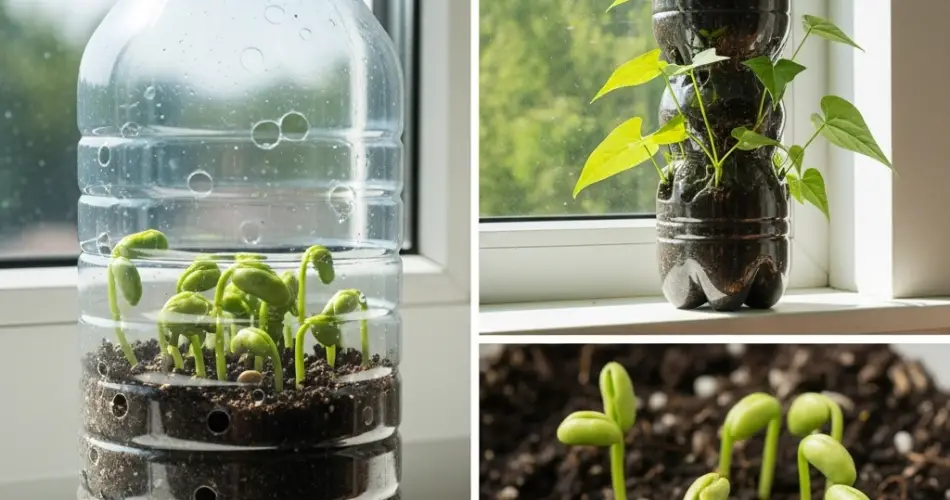Growing green beans doesn’t require a big garden. With bottle propagation, you can sprout and grow fast-growing green beans even in the smallest spaces. Using recycled plastic bottles, you can create an efficient, compact growing environment that promotes healthy seed germination and early growth. This method is perfect for home gardeners looking to maximize yield with minimal resources and is especially useful for balcony, windowsill, or indoor gardening.
Green beans (also known as string beans or snap beans) are one of the easiest vegetables to grow, making them an ideal choice for both beginner and experienced gardeners. They germinate quickly, grow rapidly, and can be harvested multiple times in a season. By starting them in plastic bottles, you can get a head start on the growing season and transplant them easily into containers or garden beds once they’re strong enough.
Why Use Plastic Bottles for Propagation?
Plastic bottles are readily available and can be transformed into mini greenhouses. They help maintain warmth and humidity—two key factors for successful seed germination. Transparent bottles also let you monitor root development, moisture levels, and overall plant health without disturbing the seedlings. Using bottles is a sustainable way to reuse plastic while reducing gardening costs.
Materials Needed
To propagate green beans in bottles, you’ll need:
-
1.5 or 2-liter plastic bottles (clear is best)
-
Scissors or a craft knife
-
Green bean seeds (bush or pole varieties)
-
Seed-starting mix or light potting soil
-
Spray bottle or watering can
-
Optional: small sticks or string for early support
Preparing the Bottle
Start by cleaning the bottle thoroughly and removing any labels. Cut the bottle horizontally about two-thirds up from the bottom. This gives you a deep container suitable for early root development.
Poke several drainage holes in the bottom of the bottle. If you’d like, you can also cut vertical slits on the sides of the bottle to promote air circulation and prevent fungal buildup in humid conditions.
Fill the bottom half with moist seed-starting mix. Avoid compacting the soil; keep it light to encourage strong root growth.
Planting the Seeds
Green beans germinate best when temperatures are between 20°C and 25°C (68°F–77°F). Plant the seeds about 2–3 cm deep in the center of the bottle, spacing multiple seeds if your container is large enough. For a standard 2-liter bottle, 2–3 seeds will fit comfortably.
Cover the seeds lightly with soil, then mist the surface with a spray bottle to settle the mix. Replace the top half of the bottle as a lid to create a humid environment. Remove the cap for airflow or leave it slightly ajar to regulate moisture buildup.
Ideal Growing Conditions
Place the bottle in a warm, sunny location, such as a windowsill or a balcony with good light. Green beans need at least 6 hours of sunlight daily. If temperatures are too low, consider keeping the bottle near a warm appliance or using a heat mat to encourage germination.
Keep the soil consistently moist but not soggy. Use a spray bottle to mist the surface regularly without dislodging the seeds. If condensation builds up heavily inside the bottle, remove the top to let excess humidity escape.
Within 5 to 10 days, you should see sprouts emerging. Once seedlings reach 7–10 cm tall, remove the bottle lid completely to expose them to fresh air and prevent damping-off disease.
Supporting Growth
As your green bean seedlings grow, they’ll quickly develop climbing vines if you’re using a pole bean variety. Insert a small stick or skewer into the soil to give them something to grab onto. If you’re growing bush beans, support is not essential, but space for lateral growth is still important.
When seedlings develop their second set of true leaves and are about 15 cm tall, they’re ready to be transplanted into larger containers, garden beds, or crate planters. Water them well before transplanting to minimize shock.
Transplanting Tips
To transplant, gently squeeze the bottle’s sides and tip it upside down to slide out the soil and root ball. Handle the seedlings by the base of the stem and avoid disturbing the roots. Plant them in rich, well-draining soil in a sunny location.
Add trellises or string supports if growing pole beans. For bush beans, allow room between plants for air circulation and easy harvesting. Water consistently, especially during flowering and pod development.
Harvesting and Beyond
Green beans grow quickly and can be harvested as early as 50–60 days after planting, depending on the variety. Pick the pods while they’re still tender for the best flavor and to encourage the plant to produce more beans.
Bottle propagation offers a practical, eco-conscious, and rewarding way to start green beans at home. It’s an excellent method for gardeners in tight spaces or for those who want to grow their own vegetables with minimal cost and equipment. With a little care and attention, your bottle-grown beans will soon be producing crisp, delicious pods ready for your table.



